

Quantum Consciousness. Movement of Atoms Entangled. Quantum entanglement is just spooky — even Einstein thought so.
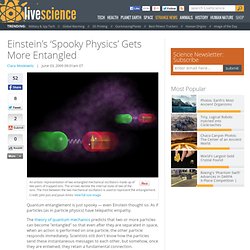
As if particles (as in particle physics) have telepathic empathy. The theory of quantum mechanics predicts that two or more particles can become "entangled" so that even after they are separated in space, when an action is performed on one particle, the other particle responds immediately. Scientists still don't know how the particles send these instantaneous messages to each other, but somehow, once they are entwined, they retain a fundamental connection. This bizarre idea riled Einstein so much he called it "spooky action at a distance. " A new study found that this eerie quantum link can apply even to situations that resemble the larger, everyday world. Previous experiments have entangled the internal properties of particles, such as spin states, but this is the first time scientists have entangled the particles' pattern of motion. Quantum Approaches to Consciousness. First published Tue Nov 30, 2004; substantive revision Thu May 19, 2011 It is widely accepted that consciousness or, more generally, mental activity is in some way correlated to the behavior of the material brain.
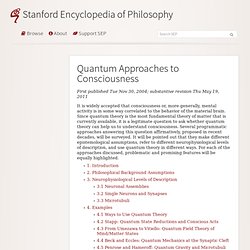
Since quantum theory is the most fundamental theory of matter that is currently available, it is a legitimate question to ask whether quantum theory can help us to understand consciousness. Several programmatic approaches answering this question affirmatively, proposed in recent decades, will be surveyed. It will be pointed out that they make different epistemological assumptions, refer to different neurophysiological levels of description, and use quantum theory in different ways. For each of the approaches discussed, problematic and promising features will be equally highlighted. 1. The problem of how mind and matter are related to each other has many facets, and it can be approached from many different starting points. 2.
Quantum mysticism. Quantum mysticism is a set of metaphysical beliefs and associated practices that seek to relate consciousness, intelligence, or mystical world-views to the ideas of quantum mechanics and its interpretations.[1][2][3][4][5][6] Quantum mysticism is considered by many scientists and philosophers to be pseudoscience[7][8][9] and "quackery".[10] Origin of the term[edit] The term originally emerged from the founders of quantum theory in the early twentieth century as they debated the interpretations and implications of their nascent theories, which would later evolve into quantum mechanics, and later after World War II, with publications such as those of Schrödinger, and the 1961 paper of Eugene Wigner.[2][11][12][13] The essential qualities of early quantum theory, and the ontological questions that emerged from it, made it difficult to distinguish between philosophical and scientific discussion as quantum theory developed into a strong scientific theory.
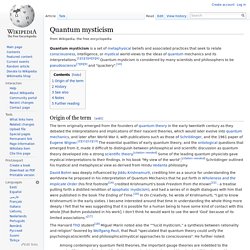
History[edit] See also[edit] Orch-OR. Orchestrated objective reduction (Orch-OR) is a controversial 20-year-old theory of consciousness conceptualized by the theoretical physicist Sir Roger Penrose and anesthesiologist Stuart Hameroff, which claims that consciousness derives from deeper level, finer scale quantum activities inside the cells, most prevalent in the brain neurons.

It combines approaches from the radically different angles of molecular biology, neuroscience, quantum physics, pharmacology, philosophy, quantum information theory, and aspects of quantum gravity.[1] The Penrose–Lucas argument[edit] The Penrose–Lucas argument states that, because humans are capable of knowing the truth of Gödel-unprovable statements, human thought is necessarily non-computable.[23] In 1931, mathematician and logician Kurt Gödel proved that any effectively generated theory capable of proving basic arithmetic cannot be both consistent and complete. Criticism of the Penrose–Lucas argument[edit] Objective reduction[edit] Resonance and the Quantum-Mind-Reality Field Paradigm. Have you ever had one of those moments where everything you do somehow just flows?
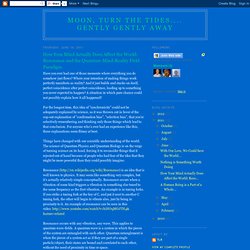
Where your intention of making things work perfectly manifests as reality? And it just builds and stacks on itself, perfect coincidence after perfect coincidence, leading up to something you never expected to happen? A situation in which pure chance could not possibly explain how it all happened? For the longest time, this idea of "synchronicity" could not be adequately explained by science, so it was thrown out in favor of the cop-out explanation of "confirmation bias", "selection bias", that you're selectively remembering and thinking only those things which lead to that conclusion.
For anyone who's ever had an experience like this, these explanations seem flimsy at best. Things have changed with our scientific understanding of the world. Resonance ( is an idea that is well known to physics. Entanglement Dr. Quantum - Heaven On Earth. A New Marriage of Brain and Computer. Clarifying the Tubulin bit/qubit - Defending the Penrose-Hameroff Orch OR Model (Quantum Biology) Stuart Hameroff about Quantum Consciousness 1 Stuart Hameroff about Quantum Consciousness 2 Stuart Hameroff about Quantum Consciousness 3 Stuart Hameroff about Quantum Consciousness 4. Quantum mind. The quantum mind or quantum consciousness hypothesis proposes that classical mechanics cannot explain consciousness, while quantum mechanical phenomena, such as quantum entanglement and superposition, may play an important part in the brain's function, and could form the basis of an explanation of consciousness.
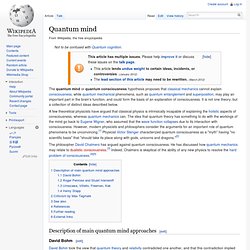
It is not one theory, but a collection of distinct ideas described below. A few theoretical physicists have argued that classical physics is intrinsically incapable of explaining the holistic aspects of consciousness, whereas quantum mechanics can. The idea that quantum theory has something to do with the workings of the mind go back to Eugene Wigner, who assumed that the wave function collapses due to its interaction with consciousness. The philosopher David Chalmers has argued against quantum consciousness. Entangled Minds. By Dean Radin, PhD Is everything connected?
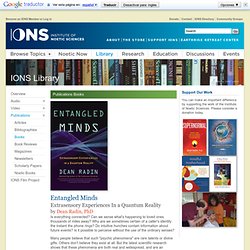
Can we sense what's happening to loved ones thousands of miles away? Why are we sometimes certain of a caller's identity the instant the phone rings? Do intuitive hunches contain information about future events? Is it possible to perceive without the use of the ordinary senses? Many people believe that such "psychic phenomena" are rare talents or divine gifts. Albert Einstein called entanglement "spooky action at a distance" -- the way two objects remain connected through time and space, without communicating in any conventional way, long after their initial interaction has taken place. Everywhere in a Flash: The Quantum Physics of Photosynthesis. By hitting single molecules with quadrillionth-of-a-second laser pulses, scientists have revealed the quantum physics underlying photosynthesis, the process used by plants and bacteria to capture light’s energy at efficiencies unapproached by human engineers.

The quantum wizardry appears to occur in each of a photosynthetic cell’s millions of antenna proteins. These route energy from electrons spinning in photon-sensitive molecules to nearby reaction-center proteins, which convert it to cell-driving charges. Almost no energy is lost in between. That’s because it exists in multiple places at once, and always finds the shortest path. “The analogy I like is if you have three ways of driving home through rush hour traffic. Scholes’ findings, published Wednesday in Nature, are the strongest evidence yet for coherence — the technical name for multiple-state existence — in photosynthesis. The Nature findings, made at room temperature in common marine algae, show that it does. Images: 1. See Also: Quantum Mechanics of Photosynthetic Light Harvesting Machinery (Google Workshop on Quantum Biology)